七年级英语上册三单元写作课教案
- 格式:docx
- 大小:12.29 KB
- 文档页数:6
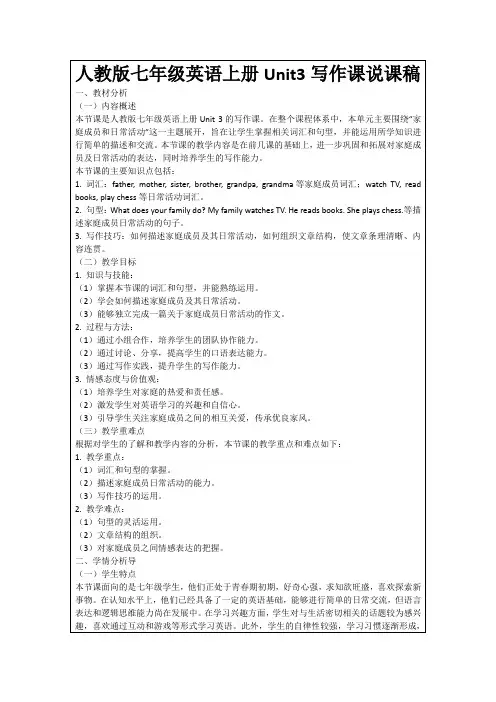
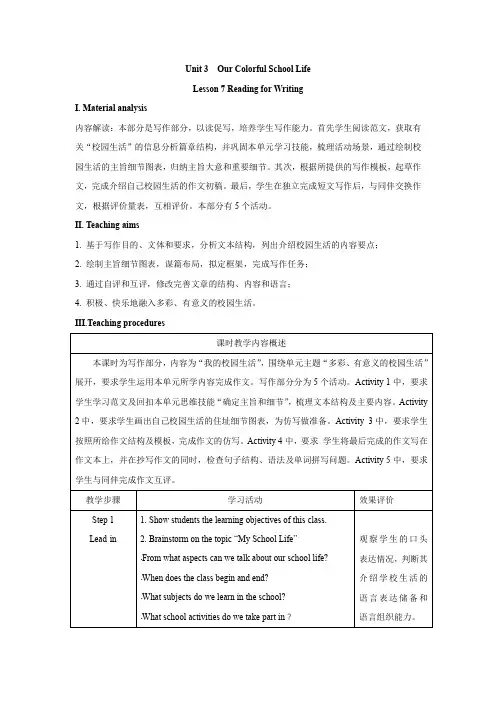
Unit 3 Our Colorful School Life
Lesson 7 Reading for Writing
I. Material analysis
内容解读:本部分是写作部分,以读促写,培养学生写作能力。
首先学生阅读范文,获取有关“校园生活”的信息分析篇章结构,并巩固本单元学习技能,梳理活动场景,通过绘制校园生活的主旨细节图表,归纳主旨大意和重要细节。
其次,根据所提供的写作模板,起草作文,完成介绍自己校园生活的作文初稿。
最后,学生在独立完成短文写作后,与同伴交换作文,根据评价量表,互相评价。
本部分有5个活动。
II. Teaching aims
1. 基于写作目的、文体和要求,分析文本结构,列出介绍校园生活的内容要点;
2. 绘制主旨细节图表,谋篇布局,拟定框架,完成写作任务;
3. 通过自评和互评,修改完善文章的结构、内容和语言;
4. 积极、快乐地融入多彩、有意义的校园生活。
III.Teaching procedures
IV. Blackboard design。
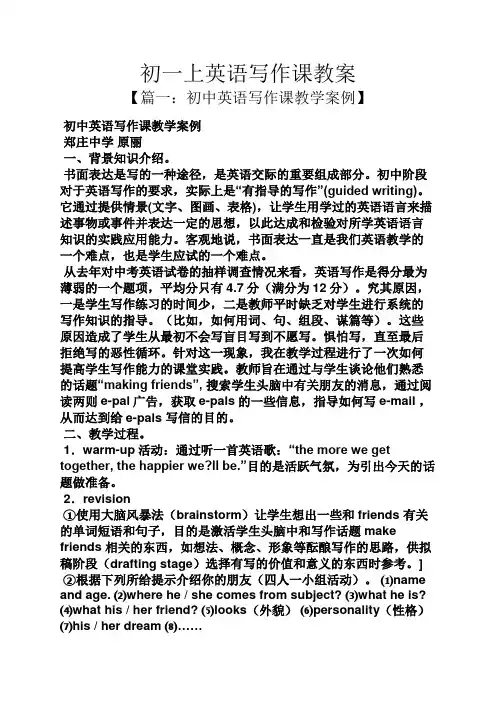
初一上英语写作课教案【篇一:初中英语写作课教学案例】初中英语写作课教学案例郑庄中学原丽一、背景知识介绍。
书面表达是写的一种途径,是英语交际的重要组成部分。
初中阶段对于英语写作的要求,实际上是“有指导的写作”(guided writing)。
它通过提供情景(文字、图画、表格),让学生用学过的英语语言来描述事物或事件并表达一定的思想,以此达成和检验对所学英语语言知识的实践应用能力。
客观地说,书面表达一直是我们英语教学的一个难点,也是学生应试的一个难点。
从去年对中考英语试卷的抽样调查情况来看,英语写作是得分最为薄弱的一个题项,平均分只有4.7分(满分为12分)。
究其原因,一是学生写作练习的时间少,二是教师平时缺乏对学生进行系统的写作知识的指导。
(比如,如何用词、句、组段、谋篇等)。
这些原因造成了学生从最初不会写盲目写到不愿写。
惧怕写,直至最后拒绝写的恶性循环。
针对这一现象,我在教学过程进行了一次如何提高学生写作能力的课堂实践。
教师旨在通过与学生谈论他们熟悉的话题“making friends”, 搜索学生头脑中有关朋友的消息,通过阅读两则e-pal广告,获取e-pals的一些信息,指导如何写e-mail ,从而达到给e-pals 写信的目的。
二、教学过程。
1.warm-up活动:通过听一首英语歌:“the more we get together, the happier we?ll be.”目的是活跃气氛,为引出今天的话题做准备。
2.revision①使用大脑风暴法(brainstorm)让学生想出一些和friends 有关的单词短语和句子,目的是激活学生头脑中和写作话题make friends 相关的东西,如想法、概念、形象等酝酿写作的思路,供拟稿阶段(drafting stage)选择有写的价值和意义的东西时参考。
]②根据下列所给提示介绍你的朋友(四人一小组活动)。
⑴name and age. ⑵where he / she comes from subject? ⑶what he is?⑷what his / her friend? ⑸looks(外貌)⑹personality(性格)⑺his / her dream ⑻……3.pre-reading 通过提问,how can you know your friends, if you haven?t seen each other for a long time? 联系朋友有很多方法,但是 one of the best ways is sending e-mails to them. do you know why?过渡今天话题的材料,快速看完两则e-pal广告,找出答案。
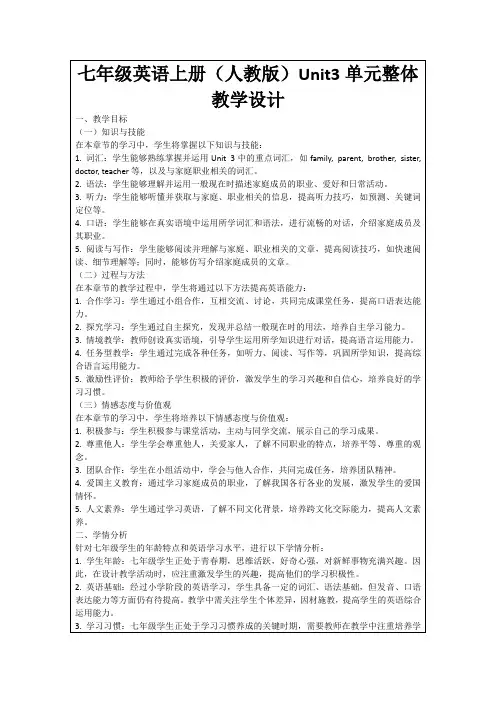
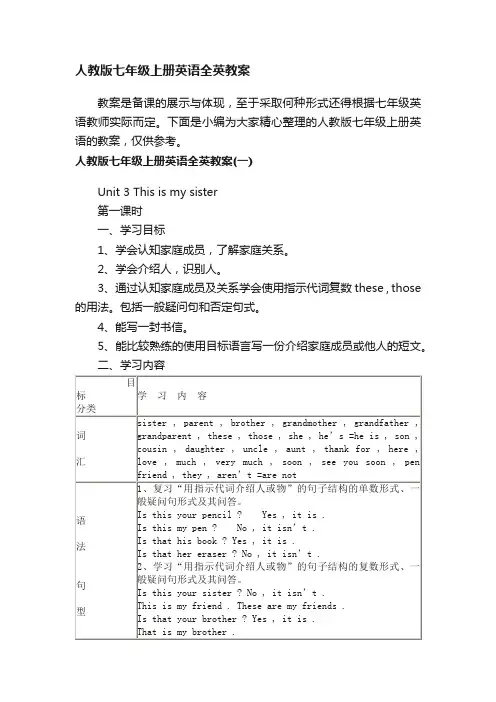
人教版七年级上册英语全英教案教案是备课的展示与体现,至于采取何种形式还得根据七年级英语教师实际而定。
下面是小编为大家精心整理的人教版七年级上册英语的教案,仅供参考。
人教版七年级上册英语全英教案(一)Unit 3 This is my sister第一课时一、学习目标1、学会认知家庭成员,了解家庭关系。
2、学会介绍人,识别人。
3、通过认知家庭成员及关系学会使用指示代词复数these , those 的用法。
包括一般疑问句和否定句式。
4、能写一封书信。
5、能比较熟练的使用目标语言写一份介绍家庭成员或他人的短文。
二、学习内容三、朗读单词1. sister n. 姐;妹2. parent n. 父或母3. brother n. 兄;弟4. grandmother n. 祖母;外祖母5. grandfather n. 祖父;外祖父6. grandparent n. 祖父/ 母;外祖父/母7. these pron . & adj.这些8. those pron . & adj.那些9. she pron .她10. he’s =he is11. son n.儿子12. cousin n.堂(表)兄弟;堂(表)姐妹13. daughter n. 女儿14. uncle n.叔;伯;舅;姨父;姑夫15. aunt n. 姨母;姑母;伯母;婶母16. thank for为……而感谢17. here adv.在这里;向这里18. love v.爱;热爱19. much adv. 很;非常20. very much 很;非常21. soon adv.不久22. see you soon ,再见。
23. pen friend 笔友24. they pron. 他(她;它)们25. aren’t =are not四、任务示范Show the Ss some pictures , point at the pictures and tell them like this :This is my father / mother / brother / sister ……That’s my sister / grandmother / grandfather ……Then ask the Ss to bring their families’ pictures and introduce people in this way .五、布置作业1、请同学们反复朗读单词,并自查能记住多少单词。
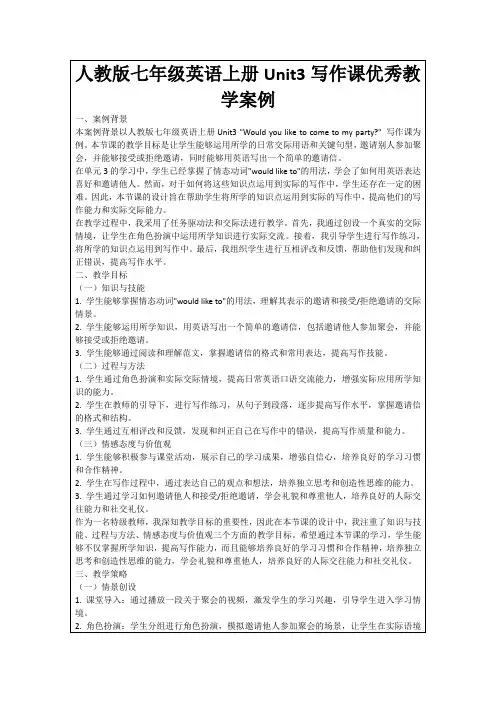
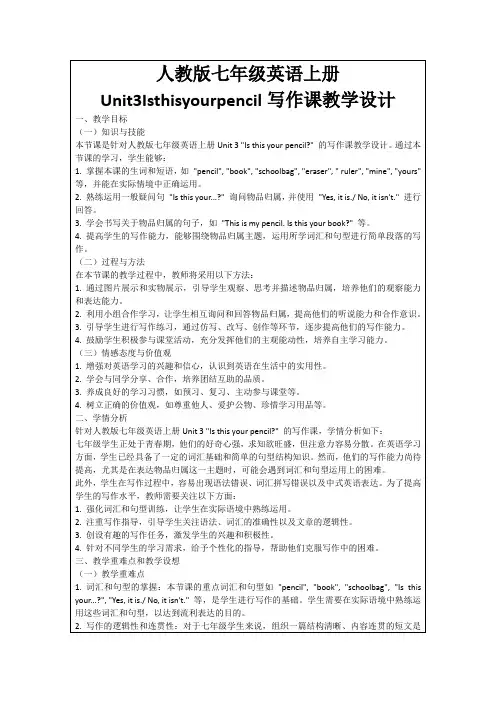
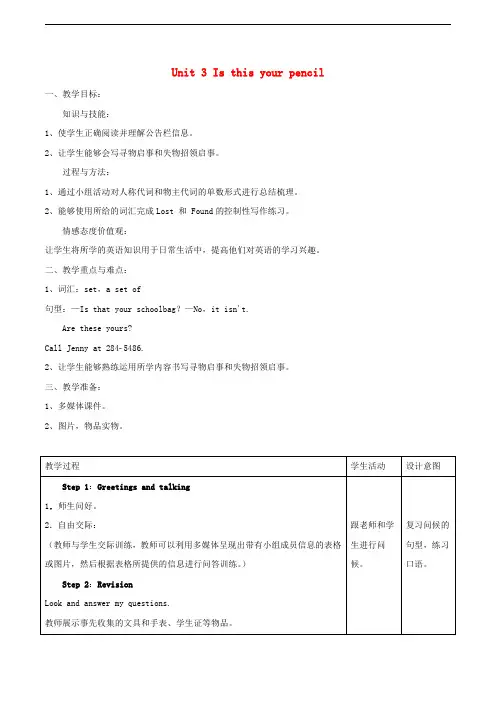
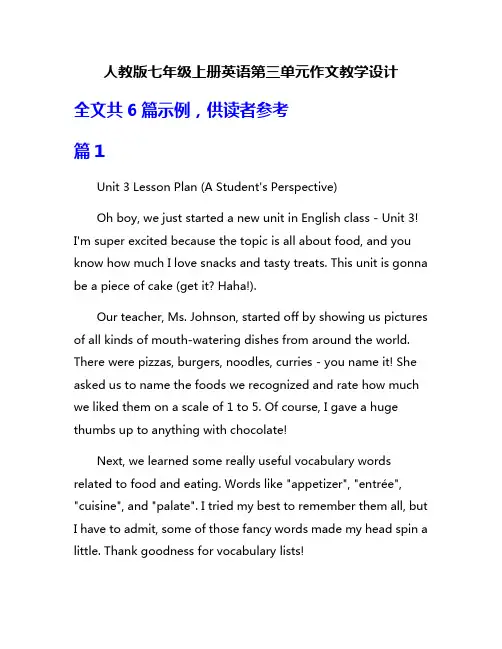
人教版七年级上册英语第三单元作文教学设计全文共6篇示例,供读者参考篇1Unit 3 Lesson Plan (A Student's Perspective)Oh boy, we just started a new unit in English class - Unit 3! I'm super excited because the topic is all about food, and you know how much I love snacks and tasty treats. This unit is gonna be a piece of cake (get it? Haha!).Our teacher, Ms. Johnson, started off by showing us pictures of all kinds of mouth-watering dishes from around the world. There were pizzas, burgers, noodles, curries - you name it! She asked us to name the foods we recognized and rate how much we liked them on a scale of 1 to 5. Of course, I gave a huge thumbs up to anything with chocolate!Next, we learned some really useful vocabulary words related to food and eating. Words like "appetizer", "entrée", "cuisine", and "palate". I tried my best to remember them all, but I have to admit, some of those fancy words made my head spin a little. Thank goodness for vocabulary lists!Then came the fun part - learning about different cultures and their traditional foods. We watched videos about Italian pasta-making, Indian spice markets, and even how chocolate is made (my favorite!). It was so cool to see how people from different parts of the world eat such diverse foods.For homework, Ms. Johnson asked us to interview our parents or grandparents about their favorite childhood dishes and cultural food traditions. I can't wait to ask my grandma about all the yummy Puerto Rican foods she used to make when she was a kid. Maybe she'll even share a recipe with me!In the next few lessons, we're going to practice ordering food at a restaurant using proper English phrases. We'll learn how to politely ask for refills, additions or substitutions to our order. I just hope nobody orders anything too stinky like durian fruit - yuck!We'll also spend some time comparing fast food tohome-cooked meals. I know fast food isn't the healthiest, but a kid can dream of unlimited fries and milkshakes, right? Ms. Johnson said we'll do activities analyzing nutrition facts and learning about balanced diets. As long as she doesn't take away my weekly pizza day, I'm cool with that.Later in the unit, we'll get to do fun food-related projects like designing our own restaurant menus and writing reviews of our favorite local eateries. I can't wait to write a scathing review of that new place that messed up my cheeseburger order. Revenge, through the power of essays!To wrap things up, our big final assessment will be giving an oral presentation about a special cultural dish or food tradition. We'll have to research the history, ingredients, and significance of the dish. I'm thinking of doing mine on s'mores because they're an amazing American camping tradition. Who doesn't love roasting marshmallows over a fire?Overall, I'm really looking forward to this delicious unit. We'll get to explore the world through food while practicing our English reading, writing, listening and speaking skills. And ifwe're lucky, maybe Ms. Johnson will even let us have a cultural food-tasting party at the end. A girl can dream, right? Now if you'll excuse me, I have to go polish off these chips before class...篇2Unit 3 - My ClassroomI can't wait to tell you about our latest English lessons! We've been learning all about describing our classroom and thedifferent objects we can find there. It's been so much fun and really helpful for improving my English skills.First up, Miss Li introduced lots of new vocabulary words related to the classroom. There were words like "desk", "chair", "blackboard", "chalk", "eraser" and so many more. We had to repeat them over and over, which was a little boring at first. But then Miss Li brought in real objects from our classroom and had us identify them using the new words. That made it way more interesting and memorable!After we learned the basic vocabulary, Miss Li taught us how to make simple sentences describing the location of different objects. We learned phrases like "next to", "in front of", "behind", "on the left/right", and "between". Then we did an activity where we had to give our classmates instructions to find specific items based on their location. It was like a treasure hunt game and we all got super competitive trying to be the first to find everything!Next up was learning adjectives to describe the characteristics of classroom objects. Words like "big", "small", "new", "old", "wooden", "metal", etc. Miss Li brought in a bunch of different desks, chairs and other things and we had to describe them using the right adjectives. There was this reallycool antique desk that must have been 100 years old! Describing that one was tough.Then we combined everything we had learned so far to create complete sentences about our classroom. Stuff like "The new metal chairs are next to the old wooden desks" or "The small green eraser is between the big books on the shelf". Writing out these descriptions was great practice for improving my English skills.But my favorite part was our final speaking activity. Miss Li put us into small groups and gave each group a different "dream classroom" scenario. My group's scenario was a classroom...in space! On a spaceship! How cool is that? We had to describe what our space classroom would look like, using all the vocabulary and grammar we had learned.My group had so much fun coming up with creative ideas. We decided our classroom would be in a big dome with a transparent ceiling so we could look at the stars during lessons. Instead of normal desks, we'd have these high-tech floating desk pads. And of course we'd have all the latest space-age teaching tools like holographic projectors and virtual reality headsets for field trips to other planets!When it was time to present our space classroom to the rest of the class, I was a little nervous. But I just imagined I was an astronaut teacher describing my futuristic classroom to the rookies. I think I did a pretty good job explaining all the awesome features, though I did mix up "left" and "right" a couple times. Whoops!Overall, this unit on describing classrooms has been excellent for building up my English skills, especially vocabulary and using adjectives correctly. I feel much more confident now giving descriptions and instructions in English. And learning all the space-related words was great preparation for my future career...as an astronaut teacher! Just kidding, but exploring other planets would be pretty cool.Up next is a unit on daily routines and schedules. I have a feeling there will be lots of useful phrases for talking about my day and the things I do at certain times. I'm already brushing up on vocabulary words like "wake up", "get dressed", "have breakfast", and so on. Cant' wait to see what fun activities Miss Li has planned! Learning English is awesome.篇3Unit 3 Writing Lesson PlanHey guys! Today I wanted to share with you the writing lesson we did in English class for Unit 3. Our teacher Ms. Wang had us work on writing a story and I thought it was really fun and helpful, so I'll explain how she taught it.First, she had us read this funny story in our textbooks about a kid who was always late for school. It was about how he overslept one morning because his alarm clock broke, and then he had all these crazy things happen to him on his way to school that made him later and later. At the end, he finally made it but was like 2 hours late! We talked about the story and answered some questions to make sure we understood everything that happened.Then Ms. Wang told us we were going to practice writing our own stories like that, with a main character and a sequence of events that leads to a conclusion or outcome at the end. She said this type of story is called a "narrative" and the important things are:Having a clear main character that the story focuses onSetting up the situation at the beginningDescribing the events that happen in a logical sequenceAdding lots of details to make it more interesting and vividBringing it to a resolution or conclusion at the endShe had us start by choosing who our main character would be - it could be ourselves or just a made-up person. I decided to make my character a kid named Mike who is always playing video games. Then we had to set up the situation, like what is Mike's regular routine and what will the initiating event be that starts getting him into trouble? I wrote that Mike's parents were going out of town and leaving him home alone for the weekend, and he got so into playing games that he made a huge mess and didn't do any of his chores.Next was the fun part - coming up with a chain of events that makes the situation worse and worse! Ms. Wang said to think of at least 4-5 major events and write them in chronological order. I had Mike first getting yelled at by his parents on a video call for not cleaning, then trying to quickly do chores but making more messes, then having to hide messes from a neighbor who stopped by, etc. For each event, Ms. Wang reminded us to add lots of descriptive details about what exactly was happening, how Mike was reacting and feeling, descriptions of the messy house, dialogue if relevant, etc.Finally, we had to come up with how the story would be resolved at the end and what the outcome was after that wholecrazy series of events. I wrote that Mike's parents ended up coming home early and he got in huge trouble, but also had a funny scene where they slip on something and make another mess, then they all have to clean together. The conclusion was Mike learning his lesson about procrastinating and making messes.After we finished drafting our narrative stories, Ms. Wang had us trade with partners and provide feedback on things like:Making sure the story events make logical sense and follow a sequenceChecking for grammar/spelling mistakesSuggesting more vivid word choices for descriptionsGiving ideas for adding more details or dialogue in certain partsThen we revised our stories based on the feedback and wrote up final drafts. On the last day, some of us got to share our stories out loud with the class!Overall, I felt like I really leveled up my narrative writing skills and made my story way more engaging and descriptive than it started. Shoutout to Ms. Wang for showing us how it's done!Writing can be hard work but it's rewarding when you craft a good story. Let me know if you have any other questions!篇4Unit 3 - Having FunHey there! It's me again, your friendly neighborhood 7th grader. Today I'm going to share my thoughts on Unit 3 from our English textbook. The unit is called "Having Fun" and boy, did we have a blast learning about it!The unit started off with a really cool text about a family visiting an amusement park. I loved reading about all the exciting rides and games they got to experience. The roller coaster sounded like an absolute thrill! I could picture myself screaming at the top of my lungs as the coaster went upside down. Though, I have to admit, I'd probably be terrified out of my mind too!After the reading, our teacher had us practice some useful sentences and vocabulary words related to amusement parks and fun activities. We learned how to express enjoyment, fear, and other emotions through simple phrases like "I'm having a great time!" and "That was scary but fun!" It's amazing how a few words can capture so much feeling.Then came my favorite part - listening to some conversations about planning a fun weekend. I really enjoyed eavesdropping on the different friend groups deciding what activities to do together. Some wanted to go to the movies, others preferred hiking or playing sports. There were so many entertaining options to choose from! It made me wish I could join in and make plans with them.Speaking activities are always a blast too. We did some fun role-plays where we had to act out making weekend plans with friends and family members. I'm a bit of a shy guy, so public speaking isn't my strong suit. But I have to admit, once I got into character, I didn't want the scene to end! It felt like I was living out my fictional weekend for real.Towards the end of the unit, we did a really cool project in groups. We had to design and pitch our own amusement park to the class, complete with ride ideas, food options, souvenirs, you name it. My group went all out with a massive indoor water park themed to an ancient civilization. We had everything from towering waterslide ruins to a lazy river representing the Nile. Maybe I have a future in amusement park design?Overall, I'd say Unit 3 was one of the most enjoyable units we've covered so far. Learning about fun activities and makingweekend plans was right up my alley as a kid. Plus, all the projects, role-plays and creative writing assignments made it so engaging. I hadn't realized how much you could cover in an English unit just from the concept of "having fun."I'm already looking forward to the next unit. Though, with my luck, it'll probably be something weird like the importance of eating your vegetables or something. A kid can dream of anall-amusement park curriculum, right? Maybe next year...篇5Here's a 2000-word lesson plan for teaching the writing section of Unit 3 in the 7th grade English textbook (PEP Edition), written from a student's perspective:Unit 3 Writing Lesson PlanHi there! Today, I'm going to share with you how our English teacher taught us to write compositions for Unit 3 in our 7th grade textbook. It was a really fun and engaging process, and by the end, I felt much more confident in my writing abilities.To start off, our teacher explained that the writing section for this unit focused on descriptive writing. She said descriptive writing is all about using vivid details to paint a picture in thereader's mind, making them feel like they're right there experiencing whatever you're describing.The first thing we did was a group brainstorming activity. Our teacher put us into small groups and gave each group a different object, like a seashell, a teddy bear, or a beautiful flower. We had to come up with as many descriptive words and phrases as we could to describe the object's appearance, texture, smell, and any other sensory details.After a few minutes, each group shared their descriptions with the class. It was really interesting to hear the different ways everyone described the same object! Our teacher praised the most creative and vivid descriptions, explaining why they were so effective.Next, our teacher did a short lesson on using descriptive language techniques like similes, metaphors, sensory details, and adjectives/adverbs. She gave examples of each technique and had us practice identifying them in sample paragraphs.Then came the fun part - we got to go outside and find something in nature to describe through writing. I chose a tall oak tree in the schoolyard. We spent about 20 minutes quietly observing our chosen subjects, jotting down notes on all the details we noticed.Back in the classroom, our teacher guided us through the process of turning our notes into complete descriptive paragraphs. We had to organize our details into an intro, body paragraphs, and a conclusion. The intro had to capture the reader's interest, the body gave vivid descriptive details, and the conclusion wrapped things up nicely.As we were writing, our teacher circulated and gave us personalized feedback. She reminded us to "show, not tell" by using lots of sensory descriptions instead of bland statements. She also encouraged us to use figurative language like similes and metaphors.Once we had a draft done, we did a "peer review" where we swapped papers with classmates and gave each other constructive criticism. I got some great suggestions for improving my descriptive language and fixing some grammatical errors.After revising our drafts based on the feedback, we handed them in to our teacher to get a grade and final comments. I was really proud of my descriptive paragraph about the oak tree!A week later, our teacher returned our graded papers. She went over some of the highest-scoring examples, explainingwhat made them so effective. Hearing the awesome descriptions my classmates wrote was really inspirational.For the final assignment, our teacher told us to write a descriptive essay of 3-5 paragraphs about a person, place, or object that was special or meaningful to us. We could choose anything, as long as we used plenty of descriptive language to make it come alive.I decided to write about my grandma's cozy living room, describing all the sights, smells, textures, and feelings of warmth and comfort I experience when I visit her. Using all the techniques we'd learned, I tried to transport the reader right into that special place.After turning in our essays, some students even volunteered to read theirs aloud to the class. It was amazing hearing the variety of perspectives and the levels of detail everyone included.Overall, this descriptive writing unit helped me improve my observation skills, vocabulary, and ability to craft vivid imagery with words. Our teacher made the lessons interactive and fun. I can't wait to continue developing as a writer!Well, that's a wrap on my behind-the-scenes look at our Unit 3 writing lessons! Let me know if you have any other questions.Writing may seem intimidating at first, but breaking it down into manageable steps makes it so much easier. Just look around you, observe closely, and let your words paint a picture. Happy writing!篇6Teaching Essay Writing in Unit 3 (A Student's Perspective)Wow, Unit 3 is all about writing essays! I was kinda nervous at first, but Miss Lee made it really fun and easy to understand. She started by explaining why essays are important. Turns out, being able to write good essays helps us share our thoughts and ideas clearly with others. It's a super useful skill for school, work, and life in general.The first thing we learned was the basic structure of an essay. Miss Lee said every essay needs to have three main parts: an introduction, body paragraphs, and a conclusion. She compared it to a burger - the introduction is the top bun, the body paragraphs are the patties and fillings, and the conclusion is the bottom bun. Cute analogy, right?For the introduction, Miss Lee taught us to start with a hook to grab the reader's attention. It could be an interesting question, fact, or quote related to the essay topic. Then we need to givesome background information to set the context. Finally, the introduction should end with a clear thesis statement that tells the reader what the essay will be about.Next up were the body paragraphs, which Miss Lee called the "meat" of the essay. Each body paragraph should focus on one main idea that supports the thesis statement. We learned to start with a topic sentence that introduces the main point, then give supporting details and examples to back it up. Miss Lee emphasized using transition words like "firstly", "additionally", and "moreover" to link our ideas smoothly.The conclusion is the last bite of the burger, wrapping everything up nicely. Here we need to restate the thesis in different words and summarize the key points from the body paragraphs. Miss Lee also suggested ending with athought-provoking question or call to action to leave a lasting impression on the reader.But writing isn't just about following a formula. Miss Lee made sure we understood the importance of having a clear purpose, organizing our thoughts logically, and using vivid examples to support our arguments. She taught us brainstorming techniques like mindmapping and freewriting to explore our ideas before drafting the essay.We also learned about different types of essays, like argumentative, descriptive, and narrative essays. Each type has its own strengths and purposes. For example, argumentative essays aim to convince the reader of a particular viewpoint, while descriptive essays paint a vivid picture using sensory details.Once we had the basics down, it was time to practice! Miss Lee gave us lots of fun prompts and topics to write about, like "Describe your dream school" or "Should kids have a longer summer break?" I really enjoyed the creative writing exercises where we got to use our imagination.My favorite part was the peer review sessions. We formed small groups and took turns sharing our drafts, giving feedback on clarity, structure, and ideas. I found it super helpful to get different perspectives from my classmates. It helped me see areas I could improve and gave me confidence in my writing abilities.Towards the end of the unit, Miss Lee taught us about editing and revising our work. We learned to watch out for common errors like spelling mistakes, run-on sentences, and passive voice. She emphasized the importance of proofreading carefully and making sure our essays flowed logically and naturally.On the last day, we had an "essay cafe" where we could dress up, sip juice boxes, and share our polished essays with the class. It was so much fun to see everyone's creativity and hard work on display! I felt really proud of the descriptive essay I wrote about my awesome summer camping trip.Overall, I'm so glad we covered essay writing in Unit 3. Miss Lee made it interesting and practical, breaking down the process into easy-to-follow steps. I used to find essays intimidating, but now I feel confident in my ability to express my thoughts and ideas clearly in writing. Bring on those college application essays - I'm ready!。

Unit3 SectionB〔3a-Self Check〕名师教案【教材版本与册数】新目标人教版七年级上册【单元名称】Unit 3 Is this your pencil?【课时】Section B 3a-Self Check 〔第5课时〕【课型】Writing〔复习写作课〕附:教学活动设计步骤过程措施目的持续性评价1预备与激活先期知识Step 1Warming-up& revisionI. Complete the conversations.A: What’s this?B: It’s a ring.A: _________________?B: R-I-N-G.A: Is this your ring?B: Yes, it is. It’s _____.A: ____________?B: It’s a watch.A: How do you spell it?B: _____________.A: ________________?1. 通过询问生活用品,进而学习如何询问单词拼写的句型。
2. 通过采用“连珠炮似的提问〞〔教师提问,学生迅速反响〕和“连锁操练〞〔学生任意提问或排头开场一一提问至排尾〕,练习介绍语句。
1. 通过询问物品,检查学生是否能用已经学过的词汇答复以下问题2. 学生是否可以复述阅读课文B: __________. It’s hers.A: _______________________? B: No, they aren’t. They’re his. II. Recite the notices on page 17.2获取新知Step 2Pre-writingWork on 3a1. Let’s work on 3a. Here are two notices but some wordsin the notes are missing. Read the notices and completethe notices with the words or phone number in the box.2. Ask some Ss read the words in the box.3. Ss read and complete the notices.4. Check the answers.1. 通过展示实物一串钥匙,教读词组aset of keys2. 指导学生通过上下文推测空白处的信息,激发学生的主动思维,逐渐培养其结合上下文寻找信息的阅读习惯。
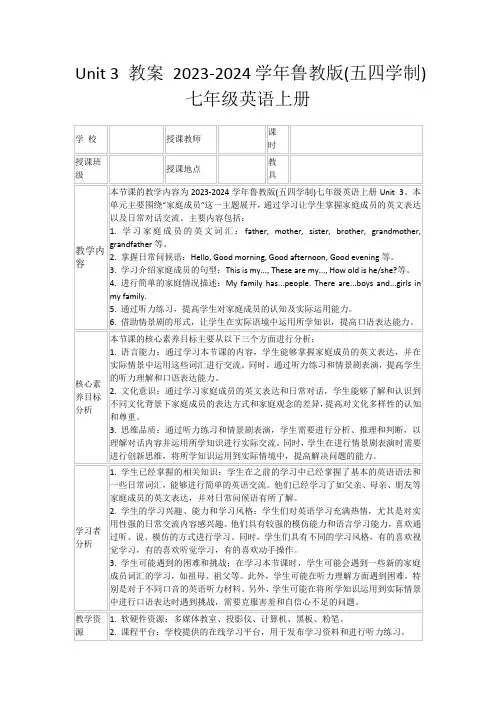
写作课英语初中教案课程目标:1. 学生能够理解和运用所学的写作技巧和表达方式。
2. 学生能够独立完成一篇有逻辑性、连贯性和条理性的作文。
3. 学生能够提高自己的写作能力和表达能力。
教学内容:1. 介绍写作技巧和表达方式。
2. 分析一篇范文,引导学生学习其中的写作技巧和表达方式。
3. 学生进行写作练习,教师进行指导和反馈。
教学步骤:Step 1: 导入(5分钟)1. 教师与学生进行简单的交流,询问学生对写作的看法和感受。
2. 教师引导学生思考写作的重要性以及写作能够带来的好处。
Step 2: 介绍写作技巧和表达方式(10分钟)1. 教师介绍一些基本的写作技巧,如如何开头、如何连接句子和段落、如何使用修辞手法等。
2. 教师介绍一些常用的表达方式,如描述、叙述、说明、论证等。
Step 3: 分析范文(15分钟)1. 教师选择一篇适合学生的范文,并引导学生分析其中的写作技巧和表达方式。
2. 教师可以让学生分组讨论,并分享自己的发现和理解。
Step 4: 学生写作练习(20分钟)1. 教师给出一个写作话题或情境,并引导学生思考和规划自己的写作内容。
2. 教师鼓励学生尽可能多地使用所学的写作技巧和表达方式。
3. 教师学生在写作过程中提供必要的帮助和指导。
Step 5: 学生展示和反馈(10分钟)1. 学生将自己的作文展示给全班同学,并分享自己的写作心得和体会。
2. 教师对学生的作文进行评价和反馈,指出其中的优点和需要改进的地方。
Step 6: 总结和作业布置(5分钟)1. 教师对本次写作课进行总结,并强调写作的重要性和持续练习的必要性。
2. 教师布置相关的写作作业,鼓励学生继续练习和提高自己的写作能力。
教学评价:1. 观察学生在写作过程中的表现和进步。
2. 评价学生的作文质量,包括逻辑性、连贯性和条理性。
3. 收集学生的反馈和意见,不断改进教学方法和内容。
以上是一篇关于英语初中写作的教案,希望对您的教学有所帮助。
七年级上册英语unit3教案教案标题:七年级上册英语 Unit 3 教案教案目标:1. 学习并掌握新单词和短语,如:hobby, play chess, play the piano, play the guitar, play basketball, play volleyball, play soccer, play table tennis, play badminton, play the drums, play the violin 等。
2. 学习并能正确运用句型:What's your hobby? My hobby is playing chess / playing the piano / playing the guitar / playing basketball / playing volleyball / playing soccer / playing table tennis / playing badminton / playing the drums / playing the violin.3. 通过听力训练,提高学生的听力理解能力,能听懂并理解有关爱好的对话。
4. 通过口语练习,培养学生的口语表达能力,能够用英语谈论自己的爱好。
教学重点:1. 学习新单词和短语,掌握其正确发音和拼写。
2. 学习并能正确运用句型:What's your hobby? My hobby is playing chess / playing the piano / playing the guitar / playing basketball / playing volleyball / playing soccer / playing table tennis / playing badminton / playing the drums / playing the violin.3. 通过听力训练,提高学生的听力理解能力。
七年级英语上册三单元写作课教案Starter Unit2 Period3(3a-3e)【教材版本与册数】新目标人教版七年级上册【单元名称】Starter U nit 2 What’s this in English?【课时】3a-3e (第3课时)【课型】Listening ,Speaking and Writing(听说写作课)【本课时教学设计】Step 9 Homework 1. Recite the newwords.2. Practice theconversation in 3c.让学生巩固本节课核心词汇和核心句型的学习,加深印象。
看学生是否能够查漏补缺,巩固本节课的知识学习。
七年级英语上册三单元写作课教案教材版本与册数:新目标人教版七年级上册单元名称:Starter Unit 2 What’s this in English?课时:3a-3e(第3课时)课型:Listening, Speaking and Writing(听说写作课)一、教材分析本单元以谈论身边的物品为核心话题,继续学习字母Ii至Rr,并围绕日常生活中的常见物品引入8个新单词。
教学重点在于让学生掌握“What’s this/that in English? It’s…”句型以及询问单词拼写的句型“Spell it, please.”。
通过图文和听力的形式,3a-3e部分将单元内容进一步拓展,旨在通过听力训练、口语练习和写作活动,让学生能够熟练运用所学句型进行语言交际。
二、教学目标语言知识目标:掌握单词和短语:spell, please, a map, an orange。
掌握求助单词拼写的句型“Spell it, please.”,并能运用该句型进行问答。
通过观看图片和多媒体展示,提供语境进行听力和口语训练。
情感态度价值观目标:在轻松愉快的氛围中学习英语,培养学生学习英语的兴趣。
三、教学重难点教学重点:运用“What’s this/that? It’s…”句型对周围的事物进行问答练习。
Part one: Teaching objectives (教学目标):(detailed详备)本单元的话题为“身体部位和情感”,要求能描述某人的外貌特征,会简单地表达自己的情感,写作时往往使用sb. has/hav e..., sb.'s favour ite...等句型,在结尾处对所描写的人物进行评价。
写作时经常会用第三人称或第一人称,时态用一般现在时。
Teaching important points 重点:能描述某人的外貌特征,会简单地表达自己的情感Teaching difficulties难点:使用sb. has/hav e..., sb.'s favour ite...等句型Common test points(常考点):作文Writing Theme(写作主题):身体部位和情感Class hour(课时):1 Repeat lesson preparationPart two: Teaching procedures (教学过程):Repeat lessonStep1: Class opening and reviewpreparation 1.Greetings (Warmup)师生问好Step2: New concepts(detailed详备)(一) 单元话题短语积累1.have fun玩得高兴2.play with和……一起玩3.do one's homework做某人的家庭作业4. listen to听……5.wave one's hand挥手6.see red火冒三丈7.a bit有点儿;稍微8.stand against/upon靠着……站9.think of想起;考虑10. in the sky在天上11. see a doctor看医生12. have a cold感冒13. stay home待在家里14. have a rest休息一下(二) 阅读下面的短文,完成相关的任务。